
Cover, Design Research: The Store That Brought Modern Living to American Homes, book designed by Pentagram, fabric pattern by Marimekko
Design Research closed its doors 31 years ago. Baby boomers remember the store like it was yesterday. D/R was where they bought their Marimekko dresses, the minute they realized a girdle was no longer required. D/R was where they touched the Kaj Franck china, buying one place-setting at a time for first apartments in Cambridge or San Francisco or New York. They copied its grand paper globes, bought rugs in Turkey to slip under their glass coffee tables, dangled wooden toys in front of their tots, and learned to make a mean tagine, using the same clay pot as Julia.
D/R’s founder, architect Benjamin Thompson, wanted to turn shopping into less of a chore, more of a creative enterprise. Thompson wrote in the Boston Globe in 1971, 18 months after his glass-walled, concrete-framed new D/R headquarters opened in Cambridge:
Just as Harvard Yard is an agora and Washington Street a fair, D/R lives in the tradition of the marketplace. Because good markets and fairs thrive on movement and action, they don’t happen in architectural “masterpieces” but in lively spaces that mix people and functions.
So the task of building anew on Brattle Street, with its beautiful residential scale and bustling intensity around Harvard Square, was a complex prospect. Could we share the new D/R with the outer world, yet keep the sense of intimacy within? Could we achieve crystalline openness without the icy purity of most glass facades? Could we blend today’s structure with Longfellow’s neighborhood, mix children and elders, old and new, store and street into a comfortable continuity of color and optimism that life is naturally all about?
Thompson’s thinking about “lively spaces that mix people and functions” led him to a second career, during and after D/R, as the joint inventor, designer and planner of the “festival marketplace” with wife Jane Thompson. As in the D/R stores, their idea at Faneuil Hall (and later Harbor Place and South Street Seaport) was to enliven old buildings with new shopping, eating and mingling experiences, curating (to appropriate a trendy word) the stores as he had curated the D/R merchandize for a mix of price points and audiences, and adding lots of free performances, classes, and good smells. However sad the festival marketplaces now seem, overrun with chain stores and tourist restaurants, the Thompsons' ideas about retail — hand-selecting the goods, maximizing the sidewalk display, re-using past architecture — are still at work today.
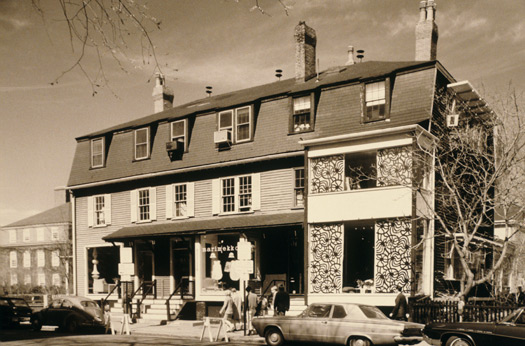
The first D/R store, which opened on Brattle Street in Cambridge, MA in 1953. Courtesy Design Research
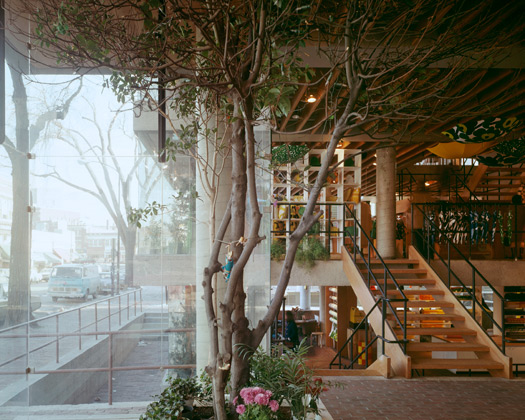

The new D/R store, which opened across the street from the original for Christmas, 1969. Photo by Ezra Stoller/ESTO
In the introduction to Jane Thompson's and my new book, Design Research: The Store That Brought Modern Living to American Homes, Design Within Reach founder Rob Forbes cites the Apple stores as the closest thing: even at 11 p.m., “The experience felt like a community center for people with shared aesthetic values; it was certainly more than just a store.” The Apple stores provide stunning architecture, a marketplace experience (high ceilings, goods laid out on tables), multiple price points (MacBook Pro to iPod case), instruction (free workshops), community (gathering ‘round the screens.) I imagine D/R’s fans would have been as shocked as Apple users that one could perform the tasks of everyday life without something from the store.
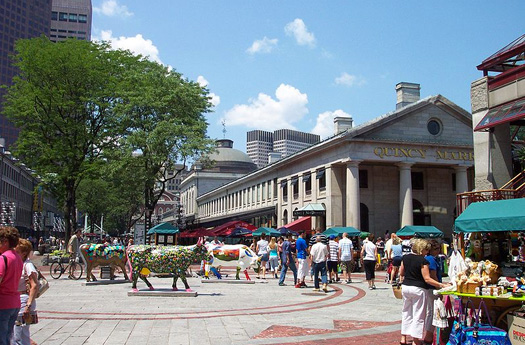
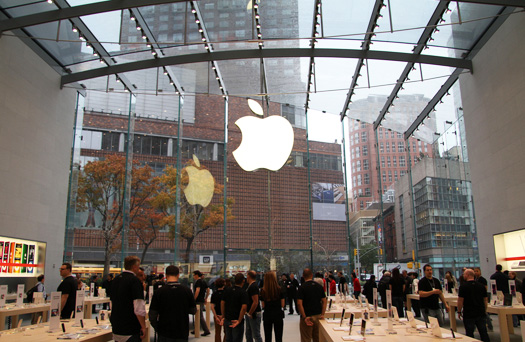
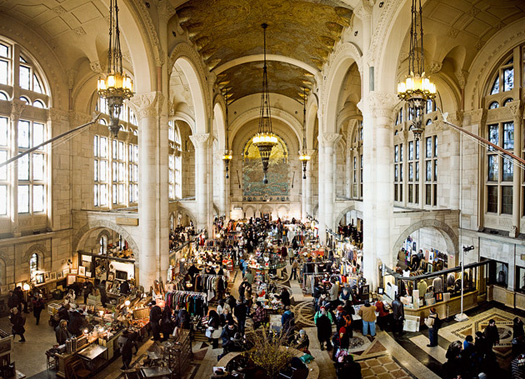
In the introduction to Jane Thompson's and my new book, Design Research: The Store That Brought Modern Living to American Homes, Design Within Reach founder Rob Forbes cites the Apple stores as the closest thing: even at 11 p.m., “The experience felt like a community center for people with shared aesthetic values; it was certainly more than just a store.” The Apple stores provide stunning architecture, a marketplace experience (high ceilings, goods laid out on tables), multiple price points (MacBook Pro to iPod case), instruction (free workshops), community (gathering ‘round the screens.) I imagine D/R’s fans would have been as shocked as Apple users that one could perform the tasks of everyday life without something from the store.

Faneuil Hall and Quincy Market in Boston, MA, designed by Benjamin Thompson & Associates, opened 1976. Photo by Chris Wood
The first D/R store, which opened in Cambridge in 1953, was a renovation of a series of 19th century houses. Thompson left the fireplaces, knowing they would indicate “home.” Apple is analogous less for its looks than because our computers and smartphones have become miniature, portable hearths. When we are with them, we are at home. So a store full of them is instantly familiar. In the same way that the Apple stores suggest an iPod made into architecture, Thompson’s D/R stores, which also infiltrated historic buildings, looked like his own butcherboard furniture made into architecture.

Apple Store on Manhattan's Upper West Side, designed by Bohlin Cywinski Jackson, opened 2009. Photo by: Matt Buchanan
What is distinctly lacking at Apple, and was ever-present at D/R, were smells. We can gather ‘round the screen, but it does not crackle or smoke. Fresh flowers and fruit were part of the everyday display at D/R. In the new store, the lower level housewares section held cooking demonstrations. Julia Child simultaneously popularized French food and the D/R pans, pots and tablecloths (brought in weekly to her WGBH set) required to entertain in the brave new world of fresh vegetables and sauces. How we cooked changed our bodies, but also our homes (open kitchens, disappearing dining rooms, expanding sofas).
Today Brooklyn is an epicenter of the same kind of foodism, though all trends point toward vintage Americana rather than classic French. (I pickled last Christmas, and felt very au courant.) And in Brooklyn, on Sundays, there is a place where you can find stunning architecture, a marketplace experience, multiple price points and community. Instruction is not explicit, but food is made before your eyes, and vendors selling bags of malt mixes for home brewing spend a lot of time in earnest explanation.
Today Brooklyn is an epicenter of the same kind of foodism, though all trends point toward vintage Americana rather than classic French. (I pickled last Christmas, and felt very au courant.) And in Brooklyn, on Sundays, there is a place where you can find stunning architecture, a marketplace experience, multiple price points and community. Instruction is not explicit, but food is made before your eyes, and vendors selling bags of malt mixes for home brewing spend a lot of time in earnest explanation.

The Brooklyn Flea, quartered Sundays in the Williamsburgh Savings Bank Tower, designed by Halsey, McCormack & Helmer, 1927. Photo by: Anton Repponen
I refer to the Brooklyn Flea, quartered on Sundays in the spectacular hall and vault of the Williamsburg Savings Bank Tower. It is a space Ben Thompson would have loved. He might have turned the long central nave into the world’s largest open-plan living room through judicious use of rugs, lamps and screens; transformed the teller’s side stalls into toy nooks or Marimekko displays. The small spaces would be bursting with color, the large one largely neutral. If allowed, surely he would have cut a spiraling staircase, something like the one in Apple’s new Upper West Side store, down from the hall and into the vault below, allowing the scents of coffee, baklava, egg sandwiches and lobster rolls to waft up.
The flea, because of its temporary status and atomized nature, can’t take charge of the room, which is a loss. (Whereas the architect of the new Limelight Marketplace, tagged “a festival of shops” and clearly Faneuil Hall-inspired, has taken far too much charge of the former church. Once you are inside, it is hard to see the stained glass windows for the awnings, display cases, and open-tread staircases scissoring past them. Not to mention the dreadful white paint job.) To have someone like Thompson mixing and matching the wares into home-like vignettes would provide some visual drama at floor level, and more focus for the vendors. In the booths you find the same searching eye, range of goods new and old, crafted here and abroad, small-scale and statement pieces as were available at D/R. But Thompson knew how to show them to best advantage.
A blending of all three might bring us closer to Thompson’s original idea of the mix: Apple’s clear sense of design, Limelight’s blend of culinary and visual treats, the flea’s feeling of community. For the Thompsons never meant D/R or Faneuil Hall to be just about sales: the point was to provide an opportunity for encounters, bringing people out of their shells and into parts of the city that had been underutilized. They also wanted to make the best of design accessible, not let it get shut up in a museum or a to-the-trade showroom. Touching the goods was an essential part of attracting and educating the consumer. The Thompsons figured out a way for preservation to feel like a festival, not a final exam. And every time we eat an Asia Dog in a bank vault, or buy shoes in a nave, we feel their legacy.
The flea, because of its temporary status and atomized nature, can’t take charge of the room, which is a loss. (Whereas the architect of the new Limelight Marketplace, tagged “a festival of shops” and clearly Faneuil Hall-inspired, has taken far too much charge of the former church. Once you are inside, it is hard to see the stained glass windows for the awnings, display cases, and open-tread staircases scissoring past them. Not to mention the dreadful white paint job.) To have someone like Thompson mixing and matching the wares into home-like vignettes would provide some visual drama at floor level, and more focus for the vendors. In the booths you find the same searching eye, range of goods new and old, crafted here and abroad, small-scale and statement pieces as were available at D/R. But Thompson knew how to show them to best advantage.
A blending of all three might bring us closer to Thompson’s original idea of the mix: Apple’s clear sense of design, Limelight’s blend of culinary and visual treats, the flea’s feeling of community. For the Thompsons never meant D/R or Faneuil Hall to be just about sales: the point was to provide an opportunity for encounters, bringing people out of their shells and into parts of the city that had been underutilized. They also wanted to make the best of design accessible, not let it get shut up in a museum or a to-the-trade showroom. Touching the goods was an essential part of attracting and educating the consumer. The Thompsons figured out a way for preservation to feel like a festival, not a final exam. And every time we eat an Asia Dog in a bank vault, or buy shoes in a nave, we feel their legacy.
